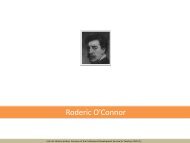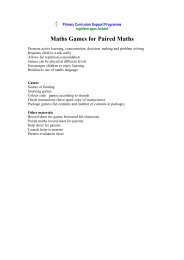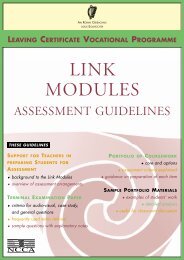GUIDELINES FOR TEACHERS - Curriculum Online
GUIDELINES FOR TEACHERS - Curriculum Online
GUIDELINES FOR TEACHERS - Curriculum Online
You also want an ePaper? Increase the reach of your titles
YUMPU automatically turns print PDFs into web optimized ePapers that Google loves.
PHYSICS<br />
FUNDAMENTAL <strong>FOR</strong>CES OF NATURE<br />
The four forces of nature are gravitation, electromagnetism,<br />
the strong nuclear force, and the weak<br />
nuclear force. All are “actions at a distance”. Gravitation<br />
and forces between charges are governed by an inverse<br />
square law, which is of unlimited range. Nuclear forces fall<br />
off much more quickly with distance and are negligible<br />
outside nuclear distances (10 –15 to 10 –14 m).<br />
Fundamental forces<br />
Relative Strength<br />
Gravitational force 1<br />
Weak nuclear force 10 25<br />
Electromagnetic force 10 35<br />
Strong nuclear force 10 38<br />
The gravitational interaction between the particles at<br />
nuclear distances is so weak that it can be neglected.<br />
FAMILIES OF PARTICLES<br />
It is through collisions of particles in accelerators that a<br />
large number of new fundamental particles have been<br />
discovered. This is sometimes called the “Particle Zoo”.<br />
The particles are symbolised by Greek and Roman letters.<br />
Some particles are positively charged, some are negatively<br />
charged, and some are neutral.If charged, the charge is<br />
always one unit, that is ±e.<br />
A typical high energy proton reaction may be:<br />
p + p → p + p + π + + π – + π o +....<br />
A large number of π mesons are created in this reaction.<br />
The meson is a particle with a mass intermediate between<br />
that of the electron and that of the proton. The π meson was<br />
in fact originally discovered in 1947 in an interaction<br />
caused by a cosmic ray proton at the top of the atmosphere.<br />
In the 1950s and early 1960s hundreds of fundamental<br />
particles were discovered and studied. Practically all of<br />
them are unstable, and decay spontaneously to other<br />
particles, with mean lifetimes sometimes as short as 10 –23 s.<br />
They are subject to the four fundamental forces of nature.<br />
FUNDAMENTAL <strong>FOR</strong>CES OF NATURE<br />
Gravitation: Keeps Earth and planets in orbit.<br />
Gives rise to weight.<br />
Sun<br />
Earth<br />
Electromagnetism:<br />
Forces between charges. Binds atoms together.<br />
Gives rise to chemical reactions between<br />
atoms and molecules.<br />
Atomic<br />
Nucleus<br />
Electron<br />
Strong nuclear force:<br />
Basic force between quarks.<br />
Binds protons and neutrons together.<br />
Strong<br />
Nuclear<br />
Force<br />
e-<br />
Weak nuclear force:<br />
Involved in radioactive decay.<br />
Weak<br />
Nuclear<br />
Force<br />
27

















